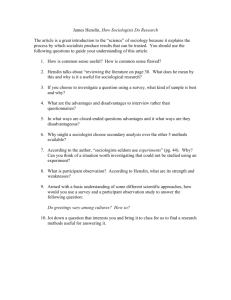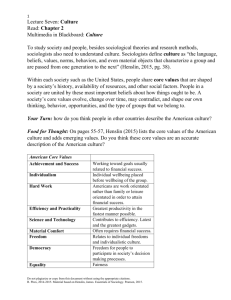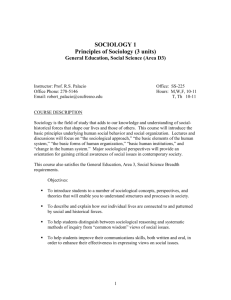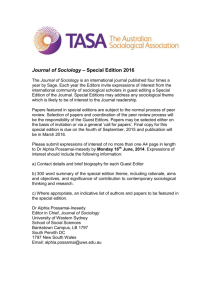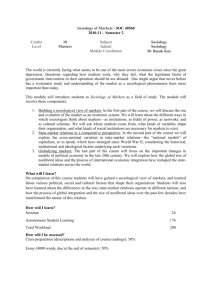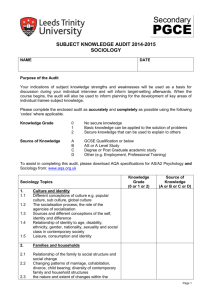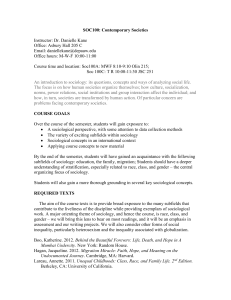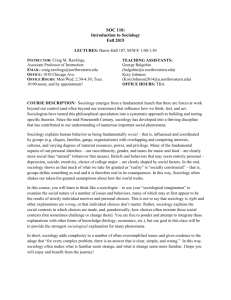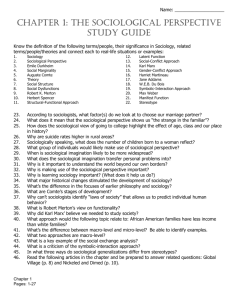Contemporary Society
advertisement
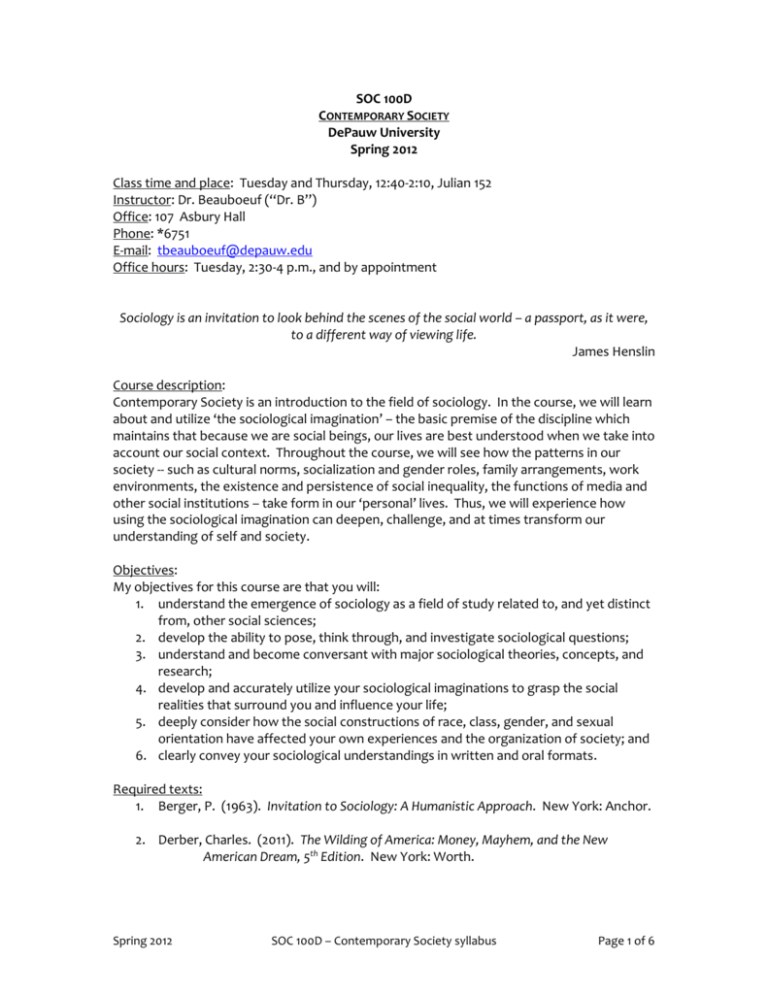
SOC 100D CONTEMPORARY SOCIETY DePauw University Spring 2012 Class time and place: Tuesday and Thursday, 12:40-2:10, Julian 152 Instructor: Dr. Beauboeuf (“Dr. B”) Office: 107 Asbury Hall Phone: *6751 E-mail: tbeauboeuf@depauw.edu Office hours: Tuesday, 2:30-4 p.m., and by appointment Sociology is an invitation to look behind the scenes of the social world – a passport, as it were, to a different way of viewing life. James Henslin Course description: Contemporary Society is an introduction to the field of sociology. In the course, we will learn about and utilize ‘the sociological imagination’ – the basic premise of the discipline which maintains that because we are social beings, our lives are best understood when we take into account our social context. Throughout the course, we will see how the patterns in our society -- such as cultural norms, socialization and gender roles, family arrangements, work environments, the existence and persistence of social inequality, the functions of media and other social institutions – take form in our ‘personal’ lives. Thus, we will experience how using the sociological imagination can deepen, challenge, and at times transform our understanding of self and society. Objectives: My objectives for this course are that you will: 1. understand the emergence of sociology as a field of study related to, and yet distinct from, other social sciences; 2. develop the ability to pose, think through, and investigate sociological questions; 3. understand and become conversant with major sociological theories, concepts, and research; 4. develop and accurately utilize your sociological imaginations to grasp the social realities that surround you and influence your life; 5. deeply consider how the social constructions of race, class, gender, and sexual orientation have affected your own experiences and the organization of society; and 6. clearly convey your sociological understandings in written and oral formats. Required texts: 1. Berger, P. (1963). Invitation to Sociology: A Humanistic Approach. New York: Anchor. 2. Derber, Charles. (2011). The Wilding of America: Money, Mayhem, and the New American Dream, 5th Edition. New York: Worth. Spring 2012 SOC 100D – Contemporary Society syllabus Page 1 of 6 3. Henslin, James. (2007). Down to Earth Sociology: Introductory Readings, 143h Edition. New York: Free Press. 4. Articles on Moodle course site Course requirements: 1. Daily class attendance, preparation, and participation For this course to be a meaningful experience for all involved, you need to take responsibility for your learning. This entails coming to class prepared to discuss assigned texts. Daily preparation is an active process of reading and re-reading materials; taking the time to make connections to your prior knowledge, previous readings, and class conversations; and identifying key questions to contribute to our discussions. Daily attendance consists of coming to class regularly and punctually (that is, coming to class late or being absent no more than twice during the semester). 2. Introducing focusing devices Each of you will have the opportunity to contribute to our appreciation of sociology’s impact on our everyday lives. Your task is to focus the class’s attention on an important argument from the text and to relate it to an aspect of contemporary society (e.g., via film clips, poetry, advertisements, news stories, pictures, and other cultural media). This artifact should be in electronic form (e.g., word document, weblink, pdf). Accompanying your artifact should be a one-page reflection that discusses: what you found significant about the text, its connection to our ongoing discussions, and the relevance of your focusing device to the text’s argument and/or implications for our understandings of society. Both your artifact and reflection should be posted on Moodle no later than midnight the night before your contribution is due. 3. Papers During the semester, you will complete two short papers in which you will apply a sociological lens to a social issue. Papers are due on specific dates and no late papers will be accepted! Details about individual papers will be passed out during the semester. 4. Exams You will also have two essay-format exams – a midterm and a final – that will ask you to respond to and synthesize key themes from the readings. Study guides will be provided a week before the exams. Spring 2012 SOC 100D – Contemporary Society syllabus Page 2 of 6 Grading: Your final grade for the course will be based on the following: 1. Daily class attendance and quality of participation …..……………15% 2. Focusing device contribution and reflection..………………...…… 15% 3. Two papers ……………..………………..………..……….…………20 % each 4. Midterm and final exams …..…………………….……….…………15% each TOTAL 100% B+ (87-89%) C+ (77-79%) D+ (67-69%) A (95%+) B (84-86%) C (74-76%) D (64-66%) F <63% A- (90-94%) B- (80-83%) C- (70-73%) D- (60-63%) Grading rubric: I will use the following criteria to evaluate your work during the course: A-level work: Reveals an accurate and nuanced (rather than superficial) knowledge of concepts discussed Includes some intriguing questions/observations that “push” the concepts to higher levels of precision Has very few typos (i.e., grammatical and punctuation errors; misspelled words) and has accurate citations B-level work: Demonstrates a generally good (but not adequately detailed) understanding of the concepts selected Offers analyses that tend to be general and gloss over important distinctions Has quite a few typos that suggest the paper was handed in without being re-read and/or edited C-level work: Demonstrates a basic understanding of the concepts, but reveals some problems in distinguishing related, but distinct, ideas Makes some claims that seem unsupported by the concepts referenced Has inconsistent, incomplete, or inaccurate references: Quote marks are often missing and the source of ideas is often unclear Has a significant number of grammatical errors and typos that at times make comprehension difficult D-level work: Demonstrates some serious misunderstandings of the concepts Lacks a focused argument and evidence to support claims Has an unacceptable number of grammatical and typographical errors Spring 2012 SOC 100D – Contemporary Society syllabus Page 3 of 6 Academic integrity policy: Cheating, plagiarism, and the submission of the work of others as your own violate DePauw’s policy on academic integrity and may result in penalties ranging from a lowered grade to course failure and expulsion. The academic integrity policy and discussion of each student’s obligations and rights are outlined in the Student Handbook -http://www.depauw.edu/univ/handbooks/dpuhandbooks.asp?ID=521&parentid=518 Note: In your papers, you will need to incorporate the ideas of our readings. When you use the general idea of an author or place this idea in your own words, you need to note the author’s name and the source of the idea – e.g., (Brown 1998: 42). When you use the exact wording and word order of an author, you need to set this information apart from your own writing with quote marks and note the author’s name and the source. All papers should include a references page with complete bibliographic information for citations. Such information is provided in the schedule of readings at the end of this syllabus. You may also find the American Sociological Association Style Guide here: http://owl.english.purdue.edu/owl/resource/583/3/ Students with disabilities: DePauw University provides reasonable and appropriate accommodations to students with disabilities. Students are responsible for contacting the Coordinator of Student Disability Services, Pamela Roberts (Harrison 302, *6267; pamelaroberts@depauw.edu), to formally request accommodations. Schedule of readings and assignments: **MOO** -- on Moodle T: 1/31 Introduction American Sociological Association website – www.asanet.org R: 2/2 What is sociology? Henslin T: 2/7 R: 2/9 T: 2/14 R: 2/16 The sociological perspective, 1-2 Henslin, What is sociology?, 8-19 Mills, The promise, 20-27 Berger, Ch. 1: Sociology as an individual pastime, 1-24and Ch. 2: Sociology as a form of consciousness, 25-53 Sociological methods Culture: The organization of everyday life Henslin Doing sociological research, 29-34 Henslin, How sociologists do research, 35-47 Jacobs, Dealing crack: Doing research with streetcorner dealers, 73-81 Henslin Cultural context of social life, 83-85 Miner, Body ritual among the Nacirema, 87-91 Stinson, Religion and morality in weight loss groups, 217-228 Henslin Clark, Sympathy in everyday life, 118-134 **MOO** Lambert, T. et al. (2003, May). Pluralistic ignorance and hooking up. Journal of Sex Research 40: 129-134. Spring 2012 SOC 100D – Contemporary Society syllabus Page 4 of 6 T: 2/21 R: 2/23 M: 2/27 Social roles Berger, Ch. 5: Sociological perspectives – Society in man, 93-110 Socialization, gender, and social identities Henslin Henslin Socialization and gender, 147-149 Henslin, On becoming male, 161-172 Eder, On becoming female, 173-179 PAPER #1 DUE ON MOODLE BY 9 A.M.! T: 2/28 R: 3/1 Goffman, The presentation of self in everyday life, 135-146 Group membership and social interactions T: 3/6 Henslin Thorne and Luria, Sexuality and gender in children’s daily worlds, 180-191 Tannen, But what do you mean?, 192-198 Henslin Social groups and social structures, 199-202 Lawson, Attacking nicely: Women selling cars, 203-216 Henslin and Biggs, Behavior in pubic places, 277-286 Henslin Thompson, Handling the stigma of handling the dead, 249-263 **MOO** Goffman, Erving. (1963). Stigma and social identity. In Stigma: Notes on the management of a spoiled identity. Englewood Cliffs, NJ: PrenticeHall, 1-9. R: 3/8 Deviance and social control Berger, from Ch. 4: Sociological perspective – Man in society, 66-78 Henslin T: 3/13 R: 3/15 Henslin Social inequalities T: 3/20 REVIEW R: 3/22 MIDTERM EXAM! 3/27 and 3/29 SPRING BREAK !!! T: 4/3 *Classism Deviance and social control, 265-267 Henslin, Eating your friends is the hardest, 277-286 Meyer, If Hitler asked you to electrocute a stranger, 269-276 Zimbardo, The pathology of imprisonment, 315-321 Henslin Social Inequality, 335-340 Katz, The importance of being beautiful, 341-348 Gans, The uses of poverty, 376-382 Henslin Higley, The US upper class, 395-406 Morris and Grimes, Moving up from the working class, 383-394 **MOO** Zweig, Michael. (2006). Six points on class. Monthly Review 58(3). R: 4/5 T: 4/10 Spring 2012 *Sexism * Racism Henslin Martin and Hummer, Fraternities and rape on campus, 349-359 **MOO** Gallagher, Charles. (2003). Color-blind privilege: The social and political functions of erasing the color line in post race America. Race, Gender & Class 10(4): 1-17. SOC 100D – Contemporary Society syllabus Page 5 of 6 **MOO** Thrupkaew, Noy. (2002). The myth of the model minority. The American Prospect, March 25. R: 4/12 Social institutions * Media Henslin Social institutions, 407-409 **MOO** Pozner, Jennifer. (2001). You’re soaking in it. Salon, January 30. T: 4/17 * Education **MOO** Kahlenberg, Richard. (2011). The class divide between Yale and Southern Connecticut. The Chronicle of Higher Education, March 25. **MOO** Trevino, Julissa. (2009). ‘Straddling’ college and working class. Campus Progress, November 19. R: 4/19 F: 4/20 *Law and Medicine Henslin Hunt, Police accounts of normal force, 470-480 Davis-Floyd, Giving birth the American way, 432-445 T: 4/24 PAPER #2 DUE ON MOODLE BY 5 P.M.! Social change R: 4/26 The Wilding of America Henslin Leidner, The McDonaldization of society, 497-507 Wishard, Caught between the ages, 535-546 Miller, Women in the military, 518-534 Ch. 1-3, pp. 1-51 T: 5/ Wilding Ch. 4-7, pp. 52-115 R: 5/3 Wilding Ch. 8-10, pp. 116-169 T: 5/8 Sociological knowledge to what ends? Berger, from Ch. 6: Sociological perspective: Society as drama, 125-139 and Ch. 7: Excursus, 151-176 R: 5/10 Review FINAL EXAM: Wednesday, May 16, 1-4 p.m. Spring 2012 SOC 100D – Contemporary Society syllabus Page 6 of 6
